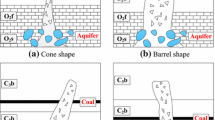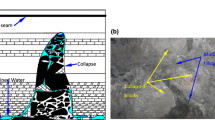Abstract
Karst Collapse Columns (KCC) are special geologic structures in the Carboniferous-Permian coalfields of the northern China. It is easy to generate severe water inrush accidents during mining activities, which can cause many casualties and property losses. To evaluate the impact of the KCC on the coalmine during the excavation and exploration of the Panel 90102 at the Yangjian Coalmine, the Shanxi Province, five KCC were detected by combining geophysical exploration and drilling information and by considering the Ordovician limestone aquifer analyses of water pressure, aquifer thickness, water-content conditions, electric conductivity, and the physical properties of the rocks. The hydrogeological characteristics of the five collapse columns (CC) are determined, which helped evaluate the impact of each collapse column’s water pressure on the Panel 90102. For the sake of solving the threat of water inrush from the five CC, two of them were grouted and consolidated to prevent the Ordovician aquifer water from flowing into the Panel 90102. The results have greatly improved the safety of the roadway advancing and mining activities in the Panel 90102.







Similar content being viewed by others
References
Asten MW (2012) Full transmitter waveform transient electromagnetic modeling and inversion for soundings over coal measures. Geophysics 52(3):279
Bao-Xiang Z, Chun-Hua L (2004) Summarization on applications to groundwater exploration by using transient electromagnetic methods. Prog Geophys 19(3):537–542 (in Chinese)
Cao ZY, Wang W, Wang Y (2012) Numerical simulation and imaging of scattered wave of sunk pillar in coal seam. Chin J Geophys 55(5):1749–1756
Combrinck M (2001) Transient electromagnetic exploration techniques: can they be applied to the landmine discrimination problem? J Afr Earth Sc 33(3–4):693–698
Dennis ZR, Cull JP (2012) Transient electromagnetic surveys for the measurement of near-surface electrical anisotropy. J Appl Geophys 76:64–73
Dong SH, Wang Q (2003) Application of tomography in radio wave tunnels perspective. J Chin Univ Min Technol 32(5):579–582
Du Y, Song C, Chen L, Yang J (2016) PS wave based parallel seismic test for pile length assessment. Soils Found 56:440–448
Essa K, Mehanee S, Smith PD (2008) A new inversion algorithm for estimating the best fitting parameters of some geometrically simple body to measured self-potential anomalies. Explor Geophys 39:155–163
Guo W, Li Y, Yin D et al (2016) Mechanisms of rock burst in hard and thick upper strata and rock-burst controlling technology. Arab J Geosci 9(10):561–583
Hatzor YH, Talesnick M, Tsesarsky M (2002) Continuous and discontinuous stability analysis of the bell-shaped caverns at Bet Guvrin, Israel. Int J Rock Mech Min Sci 39(7):867–886
Hyne NJ (1984) Geology for petroleum exploration, drilling and production
Jiao XF, Jiang ZH, Liu SC (2014) Characteristics of abnormal response of wireless electromagnetic wave perspective in tundish of coal seam. J Min Saf Eng 31(06):1001–1004
Kamenetsky FM, Trigubovich GM (2011) Transient electromagnetic field inmagneto-viscous medium. J Appl Geophys 75:373–378
Kozhevnikov PNO, Antonov EYu (2018) Magnetic viscosity effect on TEM data of an array with a fixed transmitter loop. Russ Geol Geophys 59:690–696
Li YJ, Peng SP, Li PQ (2008) Internal thermal origin mechanism of Karstic collapse column with no smoothly extrinsic cycle. J Coal Sci Eng (China) 2(14):230–234
Li JH, Zhang Y (2011a) Study on drilling technology of karst collapse column. Zhongzhou Coal 188:17–19
Li SC, Zhang X, Zhang QS (2011b) Study on diffusion mechanism and blocking method of water injection grouting for water bursting in underground engineering. Chin J Rock Mechan Eng 30(12):2377–2396
Liang F, Qian R (2011) Application of transient electromagnetic method to coal mine gobs. Chin J Eng Geophys 8(1):29–33 (in Chinese)
Liang CJ (2015) Characteristics of water damage and its application in coal mine collapse column. Energ Energ Conserv 10:29–30
Liu SD, Wu RX, Zhang PS et al (2009) Three-dimensional parallel electric surveying and its applications in water disaster exploration in coal mines. J Chin Coal Soc 34(7):927–932
Liu S, Liu J, Yue J (2014) Development status and key problems of Chinese mining geophysical technology. J China Coal Soc 39(1):19–25. https://doi.org/10.13225/j.cnki.jccs.2013.0587
Liu Y, Xu J, Zhou G (2018) Relation between crack propagation and internal damage in sandstone during shear failure. J Geophys Eng 15(5):2104–2109
Marinezt JD, Johnson KS, Neal JT (1998) Sinkholes in evaporate rocks. Am Sci 86:39–52
Mehanee S (2015) Tracing of paleo-shear zones using self-potential data inversion: case studies from the KTB, Rittsteig, and Grossensees graphite-bearing fault planes, Earth. Planets Space 67:14. https://doi.org/10.1186/s40623-014-0174-y
Mehanee S, Smith PD (2007) The influence of discretizing conductivity gradients in the 3-D finite difference em forward modelling algorithms. Aseg Extended Abstracts 4:224–233. https://doi.org/10.1071/ASEG2007ab089
Mehanee S, Zhdanov M (2002) Two-dimensional magnetotelluric inversion of blocky geoelectrical structures. J Geophys Res Solid Earth. https://doi.org/10.1029/2001JB000191
Mehanee S, Zhdanov M (2004) A quasi-analytical boundary condition for three-dimensional finite difference electromagnetic modeling. Radio Sci 39:RS6014. https://doi.org/10.1029/2004RS003029
Mehanee S, Essa KS, Diab ZE (2020) Magnetic data interpretation using a new R-parameter imaging method with application to mineral exploration. Nat Resour Res. https://doi.org/10.1007/s11053-020-09690-8
Meju MA, Fenning PJ, Hawkins TRW, Meju MA (2000) Evaluation of small-loop transient electromagnetic soundings to locate the sherwood sandstone aquifer and confining formations at well sites in the Vale of York, England. J Appl Geophys 44(2):217–236
Nabighian MN (1988) Electromagnetic methods in applied geophysics, vol 1. Theory, Society of Exploration Geophysicist (SEG), Tulsa, USA, p 513
Nabighian MN (1991) Electromagnetic methods in applied geophysics. vol 2. Applications, Society of Exploration Geophysicist (SEG), Tulsa, USA, p 347
Oda M (1986) An equivalent continuum model for coupled stress and fluid flow analysis in jointed rock masses. Water Resour Res 22(13):1845–1856
Palmer AN (1991) Origin and morphology of limestone caves. Geol Soc Am Bull 103(1):1–21
Pellerin L, Wannamaker PE (2005) Multi-dimensional electromagnetic modeling and inversion with application to near-surface earth investigations. Comput Electron Agric 46:71–102. https://doi.org/10.1016/j.compag.2004.11.017
Qiang W (2014) Progress, problems and prospects of prevention and control technology of mine water and reutilization in China. J China Coal Soc 39(5):795-805. https://doi.org/10.1322/j.cnki.jccs.2014.0478 (in Chinese)
Qiang W, Suqi Z, Shuning D et al (2012) Dissection of main technical points in “Coal Mine Safety Regulations(water control part)” modification. Coal Geol China 24(7):34-37 (in Chinese)
Rajab JSA, Tarazi EA (2018) Illuminating and optimising a three-dimensional model of an oil shale seam and its volume distribution using the transient electromagnetic induction method, central part of Jordan. Geophys Prospect 66:603–625
Saikia K, Sarkar BC (2013) Exploration drilling optimisation using geostatistics: a case in jharia coalfield, india. Applied Earth Science 115(1):13–22
Sharlov MV, Buddo IV, Misyurkeeva NV, Shelokhov IA, Agafonov YuA (2017) Transient electromagnetic surveys for highresolution near-surface exploration: basics and case studies. First Break 35(9):63–71
Shengdong L, Jing L, Jianhua Y (2014) Development status and key problems of Chinese mining geophysical technology. J China Coal Soc 39(1):19-25. https://doi.org/10.13225/j.cnki.jccs.2013.0587
Shi X, Dewei T, Qiquan Q et al (2013) Development of a drilling and coring test-bed for lunar subsurface exploration. In: IEEE International Conference on Robotics & Biomimetics. IEEE, pp 2124–2129. https://doi.org/10.1109/ROBIO.2013.6739783
Su CY, Han P (1997) The formation mechanism of karst collapse column. Shanxi Coal 05:16–18 (in Chinese)
Tiwari AK, Maurya SP, Singh NP (2018) TEM response of a large loop source over the multilayer earth models. Int J Geophys 2018:1–7
Um ES, Harris JM, Alumbaugh DL (2010) 3D time-domain simulation of electromagnetic diffusion phenomena: a finite-element electric-field approach. Geophysics 75(4):F115–F126
Wang D, Shi L (2019a) Source identification of mine water inrush: a discussion on the application of hydrochemical method. Arab J Geosci 12(2):58
Wang D, Shi L (2019b) Source identification of mine water inrush: a discussion on the application of hydrochemical method. Arab J Geosci. https://doi.org/10.1007/s12517-018-4076-3
Wannamaker PE, Hohmann GW (1984) Electromagnetic modeling of three-dimensional bodies in layered earths using integral equations. Geophysics 49(1):60
Wei J, Sun L, Huang B, Bilal M, Zhang Z (2018) Verification, improvement and application of aerosol optical depths in China Part I: Inter-comparison of NPP-VIIRS and Aqua-MODIS. Atmos Environ 175:221–233
Wiggins CM, Thomas DE (1994) Transient electromagnetic interference in substations. IEEE Trans Power Delivery 9(4):1869–1884
Wojciech KLITYŃSKI, & Paweł TARGOSZ. (2011). Principles of the transient electromagnetic method and possibilities of its application to oil and gas exploration. Geology, Geophysics\\s&\\senvironment.
Wu Q, Liu YZ, Wu XL (2016) Assessment of groundwater inrush from underlying aquifers in Tunbai coal mine, Shanxi province, China. Environ Earth Sci 75:737
Xiong-Wu HU, Zhang PS, Yan JP, Pei-Gen LI (2013) Experimental analysis on bolt interference during advanced water detection with the mine transient electromagnetic method. J Coal Sci Eng (China) 19(003):407–413
Xue GQ, Yan YJ, Li X (2007) Pseudo-seismic wavelet transformation of transient electromagnetic response in engineering geology exploration. Geophys Res Lett 34(16):377–396
Yang FT, Pang ZH, Duan ZF (2016) Distinguishing between faults and coal collapse columns based on sediment dating: a case study of the Huainan coal field China. Environ Earth Sci 75:959
Yang MJ, Yue ZQ, Lee PK (2002) Prediction of grout penetration in fractured rocks bynumerical simulation. Can Geotech J 39(6):1384–1394
Yang JM, Wei, ZZ, Gao XW, Geology Party No, & CNNC (2014) The application of the methods of high density resistivity method and transient electromagnetic to detecting coal mining goaf and to inspect grouting effect. Prog Geophys 29(1):362–369
Yin SX, Wu Q, Wang SX (2004) Hydrogeological and mechanical basics of water inrush from karstic collapse columns in Northern China. J Chin Coal Soc 02:182–185 (in Chinese)
Yin H, Shi Y, Niu H, Xie D, Wei J, Lefticariu L, Shuanxiang Xu (2018) A GIS-based model of potential groundwater yield zonation for a sandstone aquifer in the Juye Coalfield, Shangdong, China. J Hydrol 557:434–447. https://doi.org/10.1016/j.jhydrol.2017.12.043
Yin H, Zhao H, Xie D, Sang S, Shi Y, Tian M (2019a) Mechanism of mine water inrush from overlying porous aquifer in Quaternary: a case study in Xinhe Coal Mine of Shandong Province, China. Arab J Geosci 12:163. https://doi.org/10.1007/s12517-019-4325-0
Yin H, Zhao H, Xie D et al (2019b) Mechanism of mine water inrush from overlying porous aquifer in Quaternary: a case study in Xinhe Coal Mine of Shandong Province, China. Arab J Geosci 12(5):163
Yin S, Lian H, Liu D et al (2019) 70 years of investigation on Karst collapse column in North China Coalfield: cause of origin, mechanism and prevention[J]. Coal Science and Technology,47(11):1–29. https://doi.org/10.13199/j.cnki.cst.2019.11.001
Yogeshwar P, Tezkan B (2017) Two-dimensional basement modeling of central loop transient electromagnetic data from the central Azraq basin area, Jordan[J]. J Appl Geophys 136:198–210
Zacny K, Bar-Cohen Y, Brennan M, Briggs G, Cooper G, Davis K et al (2008) Drilling systems for extraterrestrial subsurface exploration. Astrobiology 8(3):665–706
Zhang WZ (2015) Three dimensional large scale simulation experiment of collapse column water inrush. J Taiyuan Univ Technol 46(6):685–690
Zhang M, Wang XH, Wang Y (2012) Numerical evaluation of uplifting effect for upper structure by grouting. J Cent South Univ 19:553–561. https://doi.org/10.1007/s11771−012−1039−9
Zhao T, Yin Y, Xiao F et al (2014) Rockburst disaster prediction of isolated coal pillar by electromagnetic radiation based on frictional effect. Scientific World J 2014:814050. https://doi.org/10.1155/2014/814050
Zhihai J, Jianhua Y, Jingcun YU (2010) Experiment in metal disturbance during advanced detection using a transient electromagnetic method in coal mines. Min Sci Technoly (China) 20(6):861–863
Zhong YP (2001) Studies on Integrate Technology of Water Prevention in Kailuan Mines. China Coal Industry Publishing House Press, Beijing
Zhu ZK, Xu ZM, Sun YJ (2013) Study on risk assessment of floor water inrush based on dimensionless multi-source information fusion. J Min Saf Eng 30(06):911–916
Acknowledgements
This research was financially supported by the National Key Research and Development Program of China (No. 2019YFC1805400), the Fundamental Research Funds for the Central Universities (No.2020ZDPY0201) and the National Natural Science Foundation of China (No. U1710253). The authors also thank the editors and reviewers for their constructive suggestions.
Author information
Authors and Affiliations
Corresponding author
Additional information
Publisher's Note
Springer Nature remains neutral with regard to jurisdictional claims in published maps and institutional affiliations.
Rights and permissions
About this article
Cite this article
Xu, Z., Sun, Y., Gao, S. et al. Comprehensive exploration, safety evaluation and grouting of karst collapse columns in the Yangjian coalmine of the Shanxi province, China. Carbonates Evaporites 36, 16 (2021). https://doi.org/10.1007/s13146-021-00675-z
Accepted:
Published:
DOI: https://doi.org/10.1007/s13146-021-00675-z




